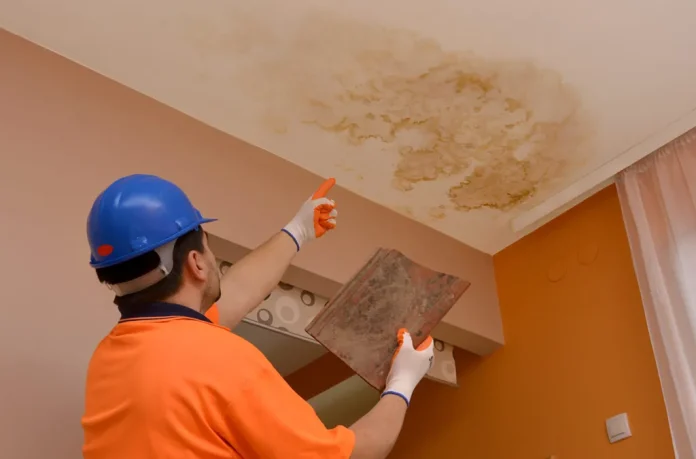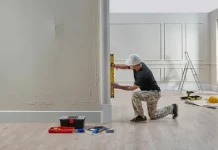Table of Contents
Understanding Water Damage in Homes
Water damage in homes is one of the most common and potentially devastating issues homeowners face. Whether from a sudden burst pipe, a slow leak, or natural events like flooding, water damage can affect the structural integrity of a home and lead to expensive repairs. Identifying water damage early is crucial, as untreated water damage can lead to more severe issues, such as mold growth and irreversible damage to walls, floors, and ceilings.
Common causes of water damage include plumbing leaks, overflowing appliances like dishwashers and washing machines, burst pipes, roof leaks, and basement flooding. Natural disasters, such as heavy rains, storms, and floods, can also be significant contributors. Ignoring water damage can escalate the issue, leading to the weakening of foundational structures, the development of mold (which poses health risks), and costly repairs to the affected areas.
1. Visible Water Stains and Discoloration
One of the first and most obvious signs of water damage is the appearance of water stains or discoloration on walls, ceilings, or floors. These stains often take on irregular shapes and can vary in color, typically appearing in shades of yellow, brown, or copper.
Water stains may appear gradually and grow over time, indicating ongoing exposure to moisture. It’s important to monitor these stains closely, as they could indicate a hidden water leak behind walls or ceilings. If left unchecked, the affected areas may weaken and lead to more extensive damage.
2. Warped or Buckled Flooring
Another telltale sign of water damage is warping or buckling in your flooring. When wood or laminate floors are exposed to water, they absorb the moisture, causing them to swell and distort. This can result in uneven floors, visible cracks, or gaps forming between the boards.
In severe cases, the floor may become so warped that it feels bumpy or soft underfoot. If you notice areas of the floor lifting or pulling away from the subfloor, it’s a clear sign that water damage is present and should be addressed immediately.
3. Peeling or Bubbling Paint or Wallpaper
Water trapped behind walls often causes paint or wallpaper to peel or bubble. This occurs when the moisture weakens the bond between the wall surface and the paint or wallpaper, resulting in visible signs of damage.
You may notice small bubbles forming on painted surfaces or sections of wallpaper starting to peel away from the wall. This is often an indication of a deeper water issue inside the wall, such as a leaking pipe or roof. Addressing this issue early can prevent more extensive damage, such as mold growth or the complete deterioration of the wall surface.
4. Musty or Damp Smells
A persistent musty or damp smell is often a strong indicator of hidden water damage. This smell typically occurs when water is trapped in walls, floors, or ceilings, creating an environment conducive to mold and mildew growth.
Even if you cannot see visible water damage, the presence of a musty odor should not be ignored. Damp smells often indicate long-term water exposure, and they can point to areas of the home where water may be collecting behind walls or under flooring. Mold spores thrive in these moist conditions and can pose health risks, so addressing the source of the smell is critical.
5. Mold Growth
Mold growth is one of the most dangerous consequences of untreated water damage. When moisture is present, mold can develop within 24 to 48 hours, thriving in areas that are dark, damp, and poorly ventilated. Mold can often be found in the corners of rooms, along ceilings, or in basements where water seepage is common.
The presence of mold not only damages the structure of your home but also poses significant health risks. Mold spores can trigger respiratory problems, allergic reactions, and even severe conditions like asthma. Because mold can spread quickly once it takes hold, it is crucial to address water damage and any resulting mold growth immediately. Professional remediation may be required to fully eliminate the mold and prevent it from returning.
6. Increased Utility Bills
An unexpected spike in your water bill may be an early sign of a hidden water leak. If you notice your water bill increasing without any significant changes in your water usage, it could mean that water is escaping somewhere in your plumbing system.
Leaks can go unnoticed for weeks or months, especially if they occur behind walls or under floors. These hidden leaks not only waste water but also contribute to water damage over time, causing structural issues and encouraging mold growth. Monitoring your water bill and checking for unexplained increases can help you detect leaks early before they cause significant damage.
7. Sagging Ceilings or Walls
Sagging or bulging ceilings and walls are serious indicators of water damage and should never be ignored. These deformities occur when water becomes trapped inside the ceiling or wall structure, causing the materials to weaken and warp under the weight.
If you notice any part of your ceiling or walls starting to sag or bulge, it’s a clear sign that there is water accumulation. This is a severe issue, as it may indicate that the structural integrity of your home is compromised. Left untreated, sagging ceilings can collapse, posing a danger to the occupants of the home and requiring extensive repairs.
8. Soft or Spongy Spots on Walls or Floors
When water is absorbed by drywall or wooden structures, these materials can become soft or spongy to the touch. If you notice areas of your walls or floors that feel unusually soft, it’s likely a sign that water damage has occurred.
This softening happens because water breaks down the fibers of wood and the composition of drywall, weakening the material over time. If left unchecked, the affected areas can deteriorate completely, resulting in expensive repairs or replacements. Addressing the issue early can prevent further damage and restore the integrity of your home’s walls and floors.
9. Cracks in the Foundation
Water damage can lead to serious structural issues, including cracks in the foundation of your home. Over time, water can seep into the foundation through tiny gaps, causing the soil underneath to shift or erode. As the soil moves, it puts pressure on the foundation, leading to cracks. These cracks often start small but can expand if the water exposure continues.
If left unaddressed, foundation cracks can lead to even more severe structural problems, such as uneven floors, misaligned doors, or compromised support beams. In extreme cases, the stability of the entire home can be at risk. It’s crucial to address water-related foundation issues promptly to prevent more costly repairs and protect the integrity of your home.
10. Sounds of Running Water When None Is Being Used
If you hear the sound of running water but none of your appliances or fixtures are in use, it could be a sign of a hidden leak. This noise may indicate that water is moving through your pipes unexpectedly, which could be happening behind walls, under floors, or in crawl spaces where leaks often go undetected.
To investigate, check all visible pipes for signs of dripping or water buildup. If the noise persists but no obvious leaks are found, it’s best to contact a professional plumber to inspect your home. Hidden leaks can cause significant water damage if not identified and repaired in time.
Conclusion: Early Detection is Key to Preventing Damage
Identifying water damage early is essential for avoiding costly repairs and preventing long-term damage to your home. The sooner you spot the signs, such as stains, warping, or strange odors, the easier it will be to mitigate the damage and protect your home from structural issues or mold growth.
Regular home inspections and routine maintenance, particularly in areas prone to leaks or water exposure, can help you catch potential problems before they escalate. If you observe any of the signs mentioned in this guide, it’s wise to consult professional water damage restoration services to assess the situation and carry out the necessary repairs. Taking proactive steps can save you time, money, and stress in the long run.








